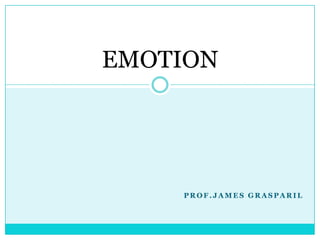
Emotion
- 1. EMOTION PROF.JAMES GRASPARIL
- 2. EMOTION -CAME FROM LATIN WORD EMOVERE MEANS TO MOVE OUT.
- 3. 3 WAYS EMOTION VARY 1. INTENSITY 2. SIMILARITY 3. POLARITY
- 4. FOUR COMPONENTS OF EMOTION 1. THE COGNITIVE COMPONENT-THE THOUGHTS,BELIEF AND EXPECTATIONS THAT DERTERMINE THE TYPE AND INTENSITY OF EMOTIONAL RESPONSE. 2. SUBJECTIVE COMPONENT-WHICH INCLUDES PLEASURE AND DISPLEASURE INTENSITY OF FEELINGS AND COMPLEXITY.
- 5. 3. BEHAVIORAL COMPONENT-THE VARIOUS FORM OF EXPRESSION THAT EMOTION MAY TAKE. EG. FACIAL EXPRESSION,BODY GESTURE,POSTURE AND TONE OF VOICE VARY WITH ANGER,JOY……. 4.PHYSIOLOGICAL COMPONENT-WHICH INVOLVES PHYSICAL CHANGES IN THE BODY.
- 6. THEORIES OF EMOTION JAMES-LANGE THEORY-STATES THAT EMOTION OCCURS AFTER BODILY CHANGES. HEART SNAKE FEAR PALPITATION
- 7. CANNON-BARD-ARGUES THAT WE EXPERIENCE PHYSIOLOGICAL AROUSAL AND EMOTION AT THE SAME TIME. SNAKE HEART FEAR PALPITATION
- 8. FACIAL FEED BACK HYPOTHESIS- PROPOSED THAT MOVEMENT OF FACIAL MUSCLES PRODUCES OR INTENSIFY EMOTIONAL REACTION.
- 9. COGNITIVE LABELING THEORY-THEORY THAT STATES THAT COGNITIVE, SUBJECTIVE AND PHYSIOLOGICAL AROUSAL COMPONENTS ARE ALL NECESSARY TO EMOTIONAL EXPERIENCE.
- 10. MEASUREMENT OF EMOTION 1. MEASUREMENT OF PHYSIOLOGICAL RESPONSE. -LIE DETECTOR -ELECTRO CARDIOGRAPH -SPHYGMOMANOMETER 2.OBSERVATION AND MEASUREMENT OF OVERT BEHAVIOR. 3. SELF REPORT.
